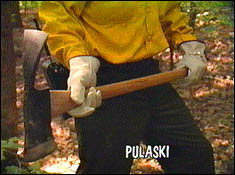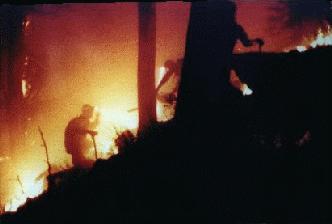Highlighting Patterns
of
Main Ideas and
Support
 Forest
fires occur every year in the United States. Some are caused by people,
others by natural causes such as lightening. No matter what the cause of
a fire, there are several factors that determine the severity of a forest
fire. Probably the most important factor is weather.Hot,
dry weather lowers the moisture content of fuels.Once
a fire has started, wind is extremely critical because it influences the
oxygen supply and the rate of spread. Forest type and conditions are also
important factors. For example, fire is more likely to occur in conifers
than in hardwoods; recently logged or bushy areas are especially hazardous
because the rate at which combustion consumes fuel is proportional to the
fuel volume and surface area.
Forest
fires occur every year in the United States. Some are caused by people,
others by natural causes such as lightening. No matter what the cause of
a fire, there are several factors that determine the severity of a forest
fire. Probably the most important factor is weather.Hot,
dry weather lowers the moisture content of fuels.Once
a fire has started, wind is extremely critical because it influences the
oxygen supply and the rate of spread. Forest type and conditions are also
important factors. For example, fire is more likely to occur in conifers
than in hardwoods; recently logged or bushy areas are especially hazardous
because the rate at which combustion consumes fuel is proportional to the
fuel volume and surface area. Since
there are obviously no fire hydrants in a forest, it is more difficult
to fight wildfires than urban fires. Tanker trucks can’t be driven in because
of all the trees and lack of roads. The trees, brush, and leaves provide
ideal fuel for the fire because they are so flammable. So how do firefighters
go about fighting them? Using a pulaski (a  combination
ax and hoe), a special tool, hotshots and smoke jumpers clear a large path
in a big circle around the fire so the blaze is contained in a ring of
dirt. This area, cleared of branches and dry wood, is known as a fireline
(a strip of land from which all brush and debris have been cleared to rob
a wildfire of its fuel). When the fire reaches this area, it runs out of
fuel and starves to death. If the fire is too large, however, planes and
helicopters fly overhead, dropping special chemicals that smother the flames.
This pink, fire-retardant chemical is called sky jell-o.
combination
ax and hoe), a special tool, hotshots and smoke jumpers clear a large path
in a big circle around the fire so the blaze is contained in a ring of
dirt. This area, cleared of branches and dry wood, is known as a fireline
(a strip of land from which all brush and debris have been cleared to rob
a wildfire of its fuel). When the fire reaches this area, it runs out of
fuel and starves to death. If the fire is too large, however, planes and
helicopters fly overhead, dropping special chemicals that smother the flames.
This pink, fire-retardant chemical is called sky jell-o.![]()
Nearly each month of every
year, somewhere in the United States, dedicated men and women endure exhausting
work, harsh living conditions, and long separations from friends and family
to protect the nation’s natural resources from the ravages of unwanted
wildfire. The work of wildland firefighters benefits us all, yet most of
us know very little about them. The U.S. Forest Service is composed of
various types of wildland firefighters with specific training and skills.
When a wildfire starts, fire managers are the first people to react. They
analyze the situation carefully to determine the best course of action.
When fire is started by natural causes, determined to be beneficial, and
not located in an area of human habitation, it is sometimes allowed to
burn naturally, under careful monitoring. If a fire is not started by natural
causes or it threatens people or structures, fire managers consider all
the factors involved and developed a suppression strategy. They also decide
what kind of firefighters they will need to implement it.“Helitack”
crews are specially trained in the use of helicopters during fire suppression.
Because they can be rapidly deployed, they are often the first to respond
to a wildfire. Shortly after helitack crews, one of two specialized firefighter
units are usually sent to fight the fire, depending on the accessibility
of the fire to roads or trails.  Smokejumpers,
specially trained firefighters who parachute from planes, attack wildfires
in remote and inaccessible areas. Personal gear, food, water, and specialized
equipment to help suppress blazes are dropped along with them. If the fire
is accessible by road or foot, hotshot crews are sent in. Hotshots are
specially trained in suppression tactics and are deployed to suppress big
fires in the most critical and high-risk areas. Hand crews, usually consisting
of 20 men and women, serve as the foot soldiers of wildland fire forces.
While hotshots are “on the frontline,” hand crews play an important “defensive
role” in wildfire fighting as their main responsibility is to construct
a “fireline” – a strip of land cleared of flammable materials – around
wildfires to control them. Engine crews, which range in size from 3 to
10 firefighters, drive in firefighting vehicles that use 250 to 750 gallons
of water and several hundred feet of hose to directly attack the head of
wildfires. Some engines carry special equipment to spray foam and chemicals
on homes and other structures to help them resist fire. All these firefighters
place themselves in danger when they confront a wildfire, but their specialized
training and equipment allow them to fight wildfires with confidence and
bravery.
Smokejumpers,
specially trained firefighters who parachute from planes, attack wildfires
in remote and inaccessible areas. Personal gear, food, water, and specialized
equipment to help suppress blazes are dropped along with them. If the fire
is accessible by road or foot, hotshot crews are sent in. Hotshots are
specially trained in suppression tactics and are deployed to suppress big
fires in the most critical and high-risk areas. Hand crews, usually consisting
of 20 men and women, serve as the foot soldiers of wildland fire forces.
While hotshots are “on the frontline,” hand crews play an important “defensive
role” in wildfire fighting as their main responsibility is to construct
a “fireline” – a strip of land cleared of flammable materials – around
wildfires to control them. Engine crews, which range in size from 3 to
10 firefighters, drive in firefighting vehicles that use 250 to 750 gallons
of water and several hundred feet of hose to directly attack the head of
wildfires. Some engines carry special equipment to spray foam and chemicals
on homes and other structures to help them resist fire. All these firefighters
place themselves in danger when they confront a wildfire, but their specialized
training and equipment allow them to fight wildfires with confidence and
bravery. ![]()